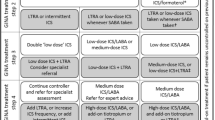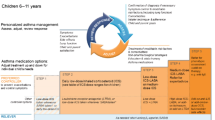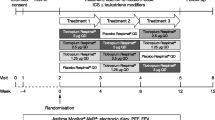Abstract
Asthma is an inflammatory disease of the airways that is best treated by minimising exposure to factors that provoke the inflammation (e.g. allergens) and by administering drugs that reduce the inflammatory response. The cornerstone of asthma treatment is inhaled corticosteroids. Their effectiveness is a result of their potent and broad anti-inflammatory properties. Antileukotriene drugs (leukotriene modifiers) provide an alternative and novel approach to the treatment of asthma. The novelty of these new compounds is that their effectiveness is firmly based on the pathophysiology of asthma, specifically the role played by the cysteinyl leukotrienes. At the same time, the availability of the antileukotriene drugs has stirred debate over when they should be used and how they compare to inhaled corticosteroids. Although the answers are not fully known at this time, the currently available published and presented data are adequate for us to draw some conclusions about their relative effectiveness and role in asthma treatment. The antileukotriene drugs are more effective than placebo, but they are not as effective as inhaled corticosteroids in improving lung function [measured as the forced expiratory volume in 1 second (FEV1) or peak expiratory flow rate (PEFR)], reducing β2-agonist use, and decreasing symptom-free days. In contrast, they may have similar beneficial effects on reducing asthma exacerbations and decreasing peripheral blood eosinophil counts. In the absence of knowing a priori the response of an individual patient to treatment with either therapy, the data favour initiating treatment with an inhaled corticosteroid. However, for patients with mild to moderate disease there are a number of circumstances that support using an antileukotriene drug first. A few examples are aspirin intolerance, predominantly exercise-induced symptoms and problems with using an inhaler or the adverse effects of inhaled corticosteroids such as dysphonia and thrush. For patients with more severe disease, inhaled corticosteroids remain the treatment of choice. Antileukotriene drugs should be considered as add-on therapy, especially in view of their possible complementary effects on reducing airway inflammation.









Similar content being viewed by others
References
Guidelines for the diagnosis and management of asthma. Expert Panel Report II. NIH publication no. 97-4051. Bethesda (MD): National Institutes of Health, 1997
Holgate S. Mediator and cytokine mechanisms in asthma. Thorax 1993; 48: 103–9
Lee TH. Cytokine networks in the pathogenesis of bronchial asthma: implications for therapy. J R Coll Phys Lond 1998; 32: 56–64
Smith LJ. Leukotrienes in asthma. Arch Intern Med 1996; 156: 2181–9
Smith LJ. A risk-benefit assessment of antileukotrienes in asthma. Drug Saf 1998; 19: 205–18
Drazen JM, Israel E, O’Byrne PM. Treatment of asthma with drugs modifying the leukotriene pathway. N Engl J Med 1999; 340: 197–206
Barnes PJ, Pedersen S, Busse WW. Efficacy and safety of inhaled corticosteroids. Am J Respir Crit Care Med 1998; 157: S1–53
Malmstrom K, Rodriguez-Gomez G, Guerra J, et al. Oral montelukast, inhaled beclomethasone, and placebo for chronic asthma. Ann Intern Med 1999; 130: 487–95
Booth H, Richmond I, Ward C, et al. Effect of high dose inhaled fluticasone propionate on airway inflammation in asthma. Am J Respir Crit Care Med 1995; 152: 45–52
Sont JK, Han J, van Krieken JM, et al. Relationship between the inflammatory infiltrate in bronchial biopsy specimens and clinical severity of asthma in patients treated with inhaled corticosteroids. Thorax 1996; 51: 496–502
Wenzel SE, Szefler SJ, Leung DYM, et al. Bronchoscopic evaluation of severe asthma. Persistent inflammation associated with high dose glucocorticoids. Am J Respir Crit Care Med 1997; 156: 737–43
Chung KF. Corticosteroid responsiveness and the evolution of asthma. Clin Exp Allergy 1998; 28Suppl. 5: 126–32
Manso G, Baker AJ, Taylor IK, et al. In vivo and in vitro effects of glucocorticoids on arachidonic acid metabolism and monocyte function in nonasthmatic tissue. Eur Respir J 1992; 5: 712–6
Cowburn AS, Holgate ST, Sampson AP. IL-5 increases expression of 5-lipoxygenase activating protein and translocates 5-lipoxygenase to the nucleus in human blood eosinophils. J Immunol 1999; 163: 456–65
Riddick CA, Ring WL, Baker JR, et al. Dexamethasone increases expression of 5-lipoxygenase and its activating protein in human monocytes and THP-1 cells. Eur J Biochem 1997; 246: 112–8
Pouliot M, McDonald PP, Borgeat P, et al. Granulocyte/macrophage colony-stimulating factor stimulates the expression of the 5-lipoxygenase-activating protein (FLAP) in human neutrophils. J Exp Med 1994; 179: 1225–32
Dworski R, Fitzgerald GA, Oates JA, et al. Effect of oral prednisone on airway inflammatory mediators in atopic asthma. Am J Respir Crit Care Med 1994; 149: 953–9
O’Shaughnessy KM, Wellings R, Gillies B, et al. Differential effects of fluticasone propionate on allergen-evoked bronchoconstriction and increased urinary leukotriene E4 excretion. Am Rev Respir Dis 1993; 147: 1472–6
Smith LJ, Hanby LA, Lavins BJ, et al. A single dose of zafirlukast reduces LTD4-induced bronchoconstriction in patients on maintenance inhaled corticosteroid therapy. Ann Asthma Allergy Immunol 1998; 81: 43–9
Reiss TF, Sorkness CA, Stricker W, et al. Effect of montelukast, a potent cysteinyl leukotriene receptor antagonist, on bronchodilation in asthmatic subjects treated with and without inhaled corticosteroids. Thorax 1997; 52: 45–8
Tamaoki J, Kondo M, Sakai N, et al. Leukotriene antagonist prevents exacerbation of asthma during reduction of highdose inhaled corticosteroid. Am J Respir Crit Care Med 1997; 155: 1235–40
Lofdahl C-G, Reiss TF, Leff JA, et al. Randomized, placebo controlled trial of effect of a leukotriene receptor antagonist, montelukast, on tapering inhaled corticosteroids in asthmatic patients. BMJ 1999; 319: 87–90
Laviolette M, Malmstrom K, Lu S, et al. Montelukast added to inhaled beclomethasone in treatment of asthma. Am J Respir Crit Care Med 1999; 160: 1862–8
Virchow IC, Prasse A, Naya I, et al. Zafirlukast improves asthma control in patients receiving high-dose inhaled corticosteroids. Am J Respir Crit Care Med 2000; 162: 578–85
Reiss TF, Chervinsky P, Dockhorn RJ, et al. Montelukast, a once-daily leukotriene receptor antagonist, in the treatment of chronic asthma: a multicenter, randomized, double-blind trial. Arch Intern Med 1998; 158: 1213–20
Calhoun WJ, Lavins BJ, Minkwitz MC, et al. Effect of zafirlukast (Accolate) on cellular mediators of inflammation: bronchoalveolar lavage fluid findings after segmental antigen challenge. Am J Respir Crit Care Med 1998; 157: 1381–9
Pizzichini E, Leff JA, Reiss TF, et al. Montelukast reduces airway eosinophilic inflammation in asthma: a randomized, controlled trial. Eur Respir J 1999; 14: 12–8
Drazen JM, Israel E. Should antileukotriene therapies be used instead of inhaled corticosteroids in asthma? Yes. Am J Respir Crit Care Med 1998; 158: 1697–8
Wenzel SE. Should antileukotriene therapies be used instead of inhaled corticosteroids in asthma? No. Am J Respir Crit Care Med 1998; 158: 1699–701
Smith LJ. Newer asthma therapies. Ann Intern Med 1999; 130: 531–2
Bleecker E, Welch MJ, Weinstein SF, et al. Low-dose inhaled fluticasone propionate versus oral zafirlukast in the treatment of persistent asthma. J Allergy Clin Immunol 2000; 105: 1123–9
Laitinen LA, Naya IP, Binks S, et al. Comparative efficacy of zafirlukast and low dose steroids in asthmatics on prn β2-agonists [abstract]. Eur Respir J 1997; 10: 419s
Busse W, Srebro SH, Edwards L, et al. Low dose inhaled fluticasone propionate versus oral zafirlukast in asthma patients [abstract]. Am J Respir Crit Care Med 1999; 159: A628
Skalky CS, Edelman JM, Polis A, et al. Montelukast sodium compared to inhaled beclomethasone dipropionate in adult asthmatics: a randomized clinical trial [abstract]. J Allergy Clin Immunol 1999; 103: S228
Busse W, Raphael GD, Galant S, et al. Low-dose fluticasone propionate compared with montelukast for first-line treatment of persistent asthma: a randomized clinical trial. J Allergy Clin Immunol 2001; 107: 461–8
Spector SL, Smith LJ, Glass M, and the Asthma Accolate Trialists Group. Effects of 6 weeks therapy with oral doses of ICI 204,219, a leukotriene D4 receptor antagonist, in subjects with bronchial asthma. Am J Respir Crit Care Med 1994; 150: 618–23
Liu MC, Dube LM, Lancaster J, et al. Acute and chronic effects of a 5-lipoxygenase inhibitor in asthma: a 6-month randomized multicenter trial. J Allergy Clin Immunol 1996; 98: 859–71
Israel E, Cohn J, Dube L, et al. Effect of treatment with zileuton, a 5-lipoxygenase inhibitor, in patients with asthma. JAMA 1996; 275: 931–6
Israel E, Rubin P, Kemp JP, et al. The effect of inhibition of 5-lipoxygenase by zileuton in mild-to-moderate asthma. Ann Intern Med 1993; 119: 1059–66
Fish JE, Kemp JP, Lockey RF, et al. Zafirlukast improves symptomatic mild to moderate asthma: a 13-week multicenter study. Clin Ther 1997; 19: 675–90
Reiss TF, Altman LC, Chervinsky P, et al. Effect of montelukast (MK-0476), a new potent cysteinyl leukotriene (LTD4) receptor antagonist, in patients with chronic asthma. J Allergy Clin Immunol 1996; 98: 528–34
Kemp J, Wanderer AA, Ramsdell J, et al. Rapid onset of control with budesonide Turbuhaler in patients with mild-to-moderate asthma. Ann Allergy Asthma Immunol 1999; 82: 463–71
Sheffer AL, LaForce C, Chervinsky P, et al. Fluticasone propionate aerosol: efficacy in patients with mild to moderate asthma. J Fam Pract 1996; 42: 369–75
Nathan RA, Nolop KB, Cuss FM, et al. A comparison of double-strength beclomethasone dipropionate (84 mcg) with beclomethasone dipropionate (42 mcg) MDI in the treatment of asthma. Chest 1997; 112: 34–9
Pauwels RA, Lofdahl CG, Postma DS, et al. Effect of inhaled formoterol and budesonide on exacerbations of asthma. N Engl J Med 1997; 337: 1405–1
Evans DJ, Taylor DA, Zetterstrom O, et al. A comparison of low-dose inhaled budesonide plus theophylline and highdose inhaled budesonide for moderate asthma. N Engl J Med 1997; 337: 1412–8
Israel E, Fischer AR, Rosenberg MA, et al. The pivotal role of 5-lipoxygenase products in the reaction of aspirin-sensitive asthmatics to aspirin. Am Rev Respir Dis 1993; 148: 1447–51
Cowburn AS, Sladek, K, Soja J, et al. Overexpression of leukotriene C4 synthase in bronchial biopsies from patients with aspirin-intolerant asthma. J Clin Invest 1998; 101: 834–46
Hasday JD, Meltzer SS, Moore WC, et al. Anti-inflammatory effects of zileuton in a subpopulation of allergic asthmatics. Am J Respir Crit Care Med 2000; 161: 1229–36
Drazen JM, Yandava CN, Dube L, et al. Pharmacogenetic association between ALOX5 promoter genotype and the response to anti-asthma treatment. Nature Genetics 1999; 22: 168–70
Anderson W, Kalberg C, Edwards L, et al. Effects of polymorphisms in promoter region of 5-lipoxygenase and LTC4 synthase on the clinical response to zafirlukast and fluticasone [abstract]. Eur Respir J 2000; 16Suppl. 31: 183s
Author information
Authors and Affiliations
Corresponding author
Rights and permissions
About this article
Cite this article
Smith, L.J. Comparative Efficacy of Inhaled Corticosteroids and Antileukotriene Drugs in Asthma. BioDrugs 15, 239–249 (2001). https://doi.org/10.2165/00063030-200115040-00004
Published:
Issue Date:
DOI: https://doi.org/10.2165/00063030-200115040-00004




